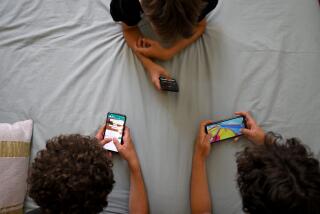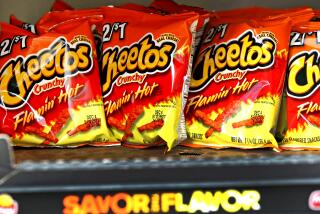Column: Middle school is the new high school. Catch up, pop culture
It might have been the full-page dress code or the Instagram photos of the already decorated lockers or all the sleek new haircuts framing expressions of careful ennui as they made their way down the early morning sidewalk. Whatever the culture-tipping factor, delivering my third and youngest child to her first day in seventh grade, I realized with a sudden jolt that middle school is the new high school.
And pop culture had best catch the heck up.
For years we have labored under the belief that adult life, or at least adult neuroses, began in high school. How else to explain the enormous role those years claim in our storytelling, personal and professional? Oh the pain, ah the pleasure of navigating those scandalous sacred halls. Middle school? That was for kids, and not even real kids. Doughy, ill-defined, in-between kids, who weren’t as adorable as they were in elementary school, or as fascinating as they would be in high school.
Yes, the boom in YA fiction created a tween subset where “Are You There God, It’s Me, Margaret” once reigned in virtual solitude, and both Nickelodeon and Disney Channel have had a few 12- to 14-year-old leads in their lineups. But most teen-based art, which is to say most adult-skewing examinations of youth, whether it be “The Catcher in the Rye” or “Euphoria,” focus on the perils and pleasures of high school.
It is during these years, we tell ourselves repeatedly, that thrilling, chilling transition between childhood and adulthood occurs.
Except that’s not true. My 12-year-old has friends who are gay, bi and trans, and is way more at ease with binary pronouns than many of my adult friends. She and her friends carry reusable straws, know how to edit photos and videos and are trained to respond to active shooters. She knows what it took me years to learn — that it is unacceptable to comment on anyone’s body or for anyone to comment on hers and that if she is made to feel physically uncomfortable by anyone, including a teacher, she has the right to leave. She will, and has, shut down anyone making a comment that seems to her racist or homophobic.
She also spent several days, and many hours on FaceTime, deciding what to wear on her first day of school. Watching the parade of styles and self-expression filing into our local middle school, I knew she was not alone in that either.
For better and worse, the transition to adulthood has already begun.
Yet we still continue to insist that high school is where this starts. There are a few exceptions. Operating in the basic kids-save-the-world universe, “Stranger Things” grants its 1980s-era middle-school-age characters young-adult emotions and abilities, while the just-opened “Good Boys” and Hulu’s recent comedy “Pen15” acknowledge the deeply resonant emotions and social forces at work in the years leading up to ninth grade.
“Good Boys” underscores the line between entering the adult world and understanding it, while in “Pen15,” co-creators Maya Erskine and Anna Kronkle’s jarring yet highly effective decision to also star as 13-year-old versions of themselves underlines the show’s revolutionary insistence that all the personality-building discovery and trauma begins long before junior prom.
Things are perhaps a bit more intensified at our local middle school, which begins in seventh grade and ends in eighth — most schools in L.A. are sixth through eighth grades. Where I grew up, in a different state and a different century, middle school went from fifth to eighth. Yes, developmentally speaking there is a big arc between 10 and 14, and the lunchtime dodgeball games did get a little out of hand. But while many eighth graders did (even then!) what eighth graders still do — experiment with smoking, sex, drinking, drugs and the power of both deep friendships and social shaming — the proximity to students who were still very much children reminded them, on a daily basis, that they were not yet even young adults.
But even then, “middle” did not begin to describe the constant tension between past and future, social and self, freedom and control that occurs in the years immediately surrounding the onset of puberty.
So we can continue telling ourselves that the struggles depicted in “Glee” or “High School Musical,” in “Booksmart” or “Superbad” begin in high school, but we are kidding ourselves. The average age for puberty has been declining in girls and boys for years; physically, anyway, middle school is certainly now the beginning of adulthood no matter how many digital controls we install or rules we make.
Now, of course, it isn’t just menstruation that is beginning earlier. Tweens are also part of the great social blur created by digital technology and globalization. Even if you choose to keep yours off Instagram or Snapchat or Tic Toc altogether, kids are in constant competition in ways far removed from school rankings and peer stylishness. The fact that the U.S. continually lags behind many other countries in test scores is made clear to every child by the end of elementary school, and even those without a smartphone can recognize young YouTube stars who have become famous (and, your kids will tell you solemnly, rich) through makeup tutorials, life hacks or simply by opening presents.
Never mind the countless stores that cater exclusively to every age group, particularly tweens and teens. When I think of my middle-school clothing, provided mostly via the Sears catalog … well, never mind. My experience is all but useless as a gauge of my kids’ lives.
And that may be the problem. Although the demographics are changing, most cultural gatekeepers — film, TV and publishing execs — are not just white and male, they’re way over 30. Their notion of youth culture is formed, at best, by what “young people tell them” and, at worst, by nostalgia for their own youth.
Our stories need to change. Middle-school students are not high school students; they are closer to children even if we expect them to save the environment, collectively raise American test scores and explain to us how our new phone works. But they deserve books and TV shows and movies that reflect their actual experience, just like the rest of us do; Harry Potter, “Diary of a Wimpy Kid” and, God forbid, “Dance Moms” can’t carry that burden alone, and neither can “Pen15.”
Watching my daughter make her way into the glorious, intimidating tempest of seventh grade, I had all the predictable parental emotions. I felt lucky she had let me walk with her (her older brother and sister did not) but I knew that, as well, as my ability to control her environment was coming to an end. She is going to have a life separate from mine; her coming of age is already occurring in a very different world than mine did.
So while some things about any first day of school will never change — new classes, new people, new schedules are exciting and intimidating — we have to acknowledge that many things have. The best we can do is keep calm and tell the truth, in our homes and in our culture.
It’s tough to be in the middle, as any middle child will tell you, but life happens in the space in between. Instead of ignoring middle school or treating it as high school prep, we need to treat it as its own significant experience.
And not just on Instagram.
More to Read
The biggest entertainment stories
Get our big stories about Hollywood, film, television, music, arts, culture and more right in your inbox as soon as they publish.
You may occasionally receive promotional content from the Los Angeles Times.







